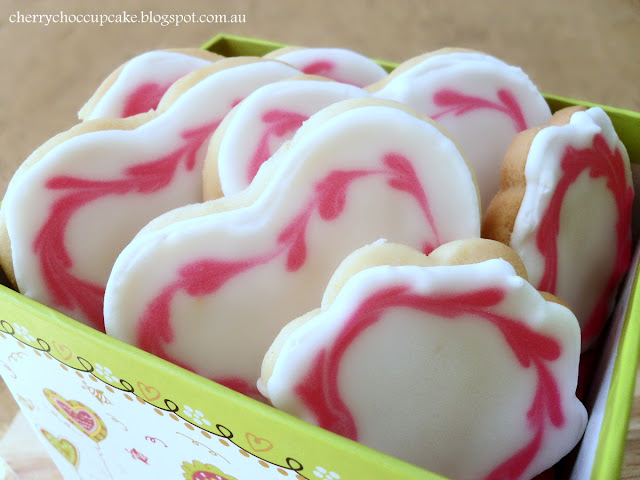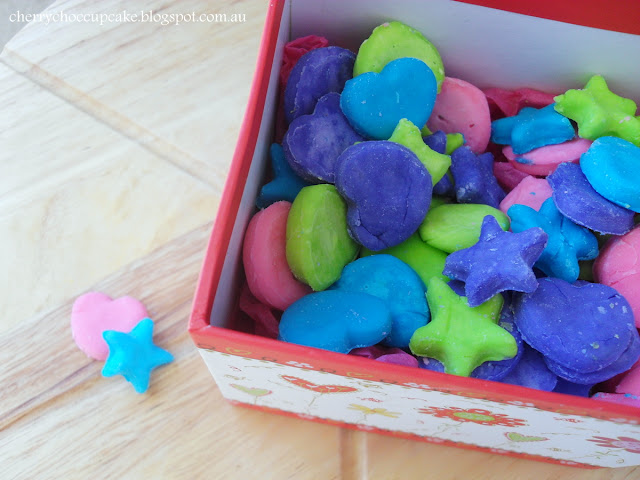Okay, so this might look like an ugly, huge, or whatever you can call it cake covered with swiss meringue buttercream and some sprinkles on top. I know, I am quite embarrased to show you my poor cake-making skills especially in smoothing out frosting, since I haven't had enough time to practice. The first EVER layer cake I made was a chocolate cake with cream cheese frosting and it was a huge disaster when I assembled them. As I was rushing and being impatient at the same time, I didn't bother to wait for the cakes to cool down and started slathering the icing on top. Big mistake! The warm cake layers melted the icing and started sliding off each other and cracking into two. It looked like a huge blob of chocolate cake at the end and my friends backed off a bit, but luckily it tasted delicious! Well, there's a little of my unfortunate baking history there.

The frosting on the cake here isn't completely white because of the pesky crumbs that made their way into the icing. I was a bit sloppy and wasn't really worried about getting cake crumbs in the frosting. Next time I really have to be more careful. I've learnt so much techniques through the internet and have come to realise how time consuming layer cakes can be. It takes me hours to make a layer cake which is pretty much why I don't make them so often. But I am going to spare more time to dedicate it for baking cakes. I also bake layer by layer and this makes it a little more difficult because you would have to weigh each of the divided batter so they would be equal when baked. Then you will have to wait for them to completely cool down before assembling them.

Here I equally divided the batter and added some food gel colouring to each. Actually, I only had 4 colours so I mixed green and blue for a kind of turquoise colour and pink and purple to make lavender. I think the colours turned out well when baked except the blue colour. It turned GREEN. I have no idea why when I bake blue tinted cakes they seem to turn green when baked. But I suspect it might have something to do with baking powder/soda. Does anyone know what happened? Anyway, I'll show you what it looks inside the cake...

Tada! Not bad for the second attempt. Can you see that the top layer above the lavender was supposed to be blue when it turned out green? My first attempt at a rainbow cake was bad, really bad. It was too sweet, too buttery, too ugly...I don't want to give you any more details about it, thank you very much. I was quite surprised to see the layers there when I carefully cut the first piece. All my friends were so impressed with the colours. Even one said that it was too pretty to eat! The layers are a little slanted though, which makes the cake domed, but that really didn't matter because it tasted so fluffy and delicious.
I got the idea from the most popular and best design of modern cake history: Whisk Kid's
Super Epic Rainbow Cake. If you've never seen or even heard of the rainbow cake, well, you must have been hiding in a hole. It is everywhere on the internet. Search on google and you'll have so many results of rainbow cakes. I've seen so many bakers try it out and that was to the point that I had to make my own.
The recipe states that you would need to use 9 egg whites and 452 grams of butter for the frosting, which I decided was waaaay too much. I wasn't prepared to use and eat 9 eggs and 4 sticks of butter! So I just stuck with 5 egg whites to frost and thinly spread it between the layers. 226 grams of butter is enough fat for me. I also added some strawberry jam to each layer and that gave it a beautiful flavour and moistness to the cake. You can use any jam you like; apricot, raspberry, grape...
Adapted from Whisk Kid's
Super Epic Rainbow Cake.
Multi-coloured Rainbow Cake
Ingredients for white cake:
226 grams (2 sticks) butter, room temperature
2 cups (400 g) sugar
5 egg whites, room temperature
2 teaspoons of vanilla
3 cups (426 g) flour
4 tsp of baking powder
½ tsp of salt
1 1/2 cups (355 ml) milk, warmed for 30 sec in microwave to bring to room temperature
6 different food gel colours
Method:
1. Preheat the oven to 177 degrees C or 350 degrees F. Grease and line cake pans with baking paper (I had two 8 inch pans).
2. In a medium bowl, sift the flour, baking powder and salt together. Separate the eggs and keep the egg whites all in one bowl and set aside.
3. Cream the sugar and butter in an electic mixer until light and fluffy, then slowly add the egg whites a little at a time and the vanilla until fully incorporated. Mix in the flour mixture and milk alternating between each in 2 parts so it forms a smooth, white cake batter.
4. Divide the batter into six bowls which is about 1 cup each OR weigh the batter by weighing the empty mixing bowl and then subtract the weight of the bowl from the final weight of the batter in it. Divide the number by six and add that weight of batter to each bowl to ensure equal layers. Add your desired food gel colours to each bowl until it is the shade you want.
5. Pour the batter in the prepared pans and bake in preheated oven for about 15 minutes each until the skewer inserted comes out clean. Let them cool in the pan for 10 minutes before removing them and allowing them to rest and cool completely on a wired rack or put them in the fridge to speed up the cooling process. You wouldn't want to work with warm or unsettled cake layers!
Swiss Meringue Buttercream to frost, thinly fill and crumb coat
Ingredients:
5 egg whites
1 cup (200 grams) of sugar
226 grams (2 sticks) of butter, chopped into small pieces and at room temperature
1 tsp of vanilla extract
Method:
1. Cook the egg whites and sugar in a double boiler (or a heatproof bowl over a small simmering saucepan of water) and whisk constantly over medium heat until fully dissolved. The mixture should be hot and when you rub it between your fingers, it is smooth with no grains of sugar.
2. Pour into another bowl and whip the mixture with an electric mixer on high speed until it comes to room temperature and it turns to stiff peaks. Slowly add the pieces of butter while whisking on medium speed one after the other when one piece is fully incorporated. When the all the butter is added, whisk on a high speed until it is smooth and has come together nicely for about 5 minutes. If it is soupy, put it in the fridge for 10 mins and whisk again. If it becomes curdled, just keep whisking and it will eventually turn into a silky smooth buttercream.
3. Add the vanilla and beat until smooth. Use it straight away.
Assembly:
1. Stack the cakes in your preferred order and add a thin layer of jam to each, followed by a small amount of the buttercream. Keep filling and stacking until you reach the top, crumb coat with a thin layer of frosting on the top and sides to seal in the crumbs and refridgerate for about 15 minutes.
2. Frost the cake with the remaining buttercream and smooth it out with an offset spatula running under hot water. Add sprinkles on top of the cake if you like or sprinkle it with any other topping.
3. Put it in the fridge to rest overnight and bring it to room temperature when it is ready to serve. This will soften the frosting as it is hard and buttery when cold.























